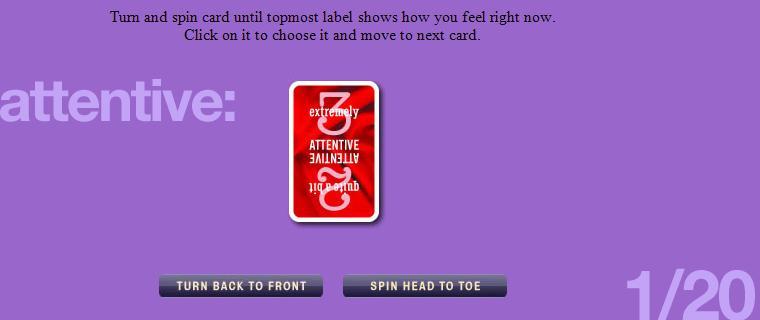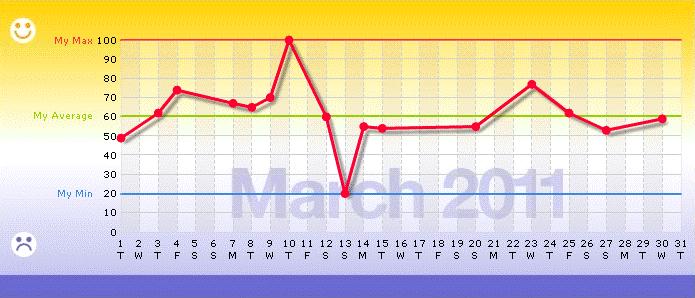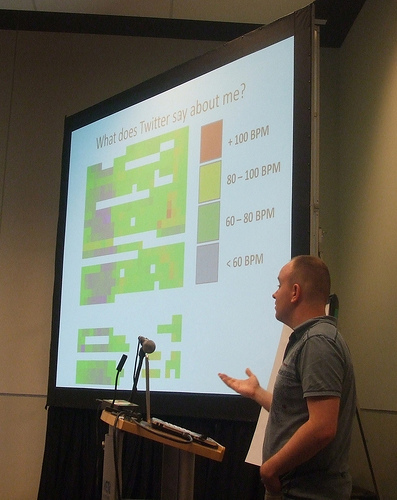Admin: Please welcome to the site our new Physiological Computing blogger.
My name is Ute Kreplin and I am a new PhD student at Liverpool John Moores University under the supervision of Dr Steven Fairclough. My PhD research topic is on Neuroaesthetics with a focus on “interest” in the aesthetic experience and its psychophysiological underpinnings. I am also very interested in positive psychology, which I am pursuing through studies at the University of East London. I am combining my interest in positive psychology and physiological computing in this blog, which will hopefully be my first of many.
I have been introduced to body blogging through Kiel who describes it as: the act of logging how your body changes over time using web technology (e.g. a blog). This can be achieved through wearable sensors that allow the continuous recording of personal data without our intervention. The fascination for me is that this log can be used to inform ourselves how our activities and environment affects us in our day to day lives (read more on body blogging here).
Kiel posed some interesting questions of how our physiology may inform our day to day activities if we have them laid out in front of us, and if our behaviours will change if we become more aware of how different activities and environmental changes affect us. This is what I would like to explore further by combining the self-assessment tool Moodscope with The Body Blogger [platform]. But first I would like to describe Moodscope and some of its good and bad points in more detail.
What is Moodscope?
Moodscope, a website that tracks your mood, was developed by John Cousin to help him cope with bi-polar disorder. I discovered Moodscope whilst doing some reading around my PhD and fell in love with it. Moodscope draws on a number of positive psychology concepts, with a slightly altered version of the Positive and Negative Affect Scale (PANAS) as its main component. The PANAS was developed by Watson, Clark, and Tellegen (1988) with the aim to create a scale with relatively pure markers of either positive or negative affect. PA reflects the extent to which a person feels positively engaged with the environment, whereas NA is the dimension of subjective distress and un-pleasurable engagement.

Figure 1 - Screenshot of Moodscope PANAS "Attentive" Card
Cousin developed a series of 20 playing cards (see Fig 1) based on the PANAS questionnaire. Each card represents a different emotional word and each quadrant of the card is marked with a different score ranging from ‘not at all’ to ‘extremely’ thereby acting as a Likert scale (omitting ‘moderately’ from the original 5-point Likert scale of the PANAS). PA and NA are mapped onto a two dimensional space to obtain an overall score. This score is given to the user in percentage and plotted along a graph, providing the opportunity to track daily mood (see Fig 2). It is possible to comment with up to 140 characters on each score. In addition you are asked to invite ‘buddies’, people that you trust, who receive an email with your score and access to your graph.

Figure 2 Screenshot of Moodscope Graph
The latter two aspects draw on benefits of writing which has been shown to promote well-being following traumatic experiences ( King & Miner, 2000; Pennebaker, 1993) as well as positive everyday events (e.g. Seligman et al., 2005; Lyubomirsky et al., 2006). Connecting to others benefits close relationships which in turn facilitate coping in stressful situation and illness as well as benefiting overall greater happiness (e.g. Abbey & Andrews, 1985; Myers, 2000; Pavot, Diener, & Fujita, 1990) *.
Problems Tracking my Mood
Using the PANAS to track my daily mood was a fascinating prospect of a new use to a questionnaire and I enjoyed engaging with it. However, I found that even on my happiest day I did not exceed a score of 77% and on average scored 56%. Since Moodscope assumes that the higher the score the better the mood, I must be fairly miserable most of the time. Looking at this in more detail showed that the user is asked to score his/her overall mood at the moment the test is taken (i.e. how you feel right now), and although the PANAS can be administered with these instructions, Moodscope assumes that this is your daily score and will not allow you to retake the test to see if your mood has changed throughout the day**. The PANAS suggests that instructions relating to ‘now’ tap directly into emotions, whereas instructions relating to longer time scales (e.g. day, week etc.) relate to overall mood states. Thus I found that my scores reflected more accurately the emotions I felt whilst conducting the test but often misinterpreted my overall daily mood.
Its assumption that you are ‘at your best’ when you are scoring higher does not allow for normal negative emotions. A score of 100% is achieved by scoring four on all positive aspects and zero on all negative, a score that I find unattainable. Critiques (e.g. Smith, 2008) have argued that positive psychology tries to eliminate negative feelings through the quest for happiness. Moodscope appears to follow this by ignoring the benefits and normality of some negative affect***. This stands separate from the original PANAS that aims for a 3/1 ratio of positive and negative affect respectively. Diener and Seligman (2002) found that even very happy people reported occasional unhappiness or neutral moods, although these moods were not extreme. They also showed that very happy people are seldom euphoric, instead they feel medium to moderately strong pleasant emotions much of the time allowing for an increase in mood after special events.
A critique of the PANAS is that several items are not actually emotions (e.g. alert), as well as several important positive emotions for well-being are missing from the scale (e.g. love, contentment, (Shiota, Keltner, & John, 2006)). This may also be a problem here as ‘alert’ at the present moment does not reflect my overall emotional state throughout the day, but rather reflects my present condition. This might account for my generally lower evening scores were I felt tired rather than alert.
Proposal – Tracking My Mood using Moodscope and The Body Blogger
Due to these discrepancies in Moodscope I am eager to see how body blogging can complement or contradict Moodscope. I would like to see how my physiological state matches my (subjective) psychological state an hour before taking the test and throughout the whole day and which, if any, is more closely related to my Moodscope score. In order to make sense of the data I intend to use heat-maps (see Fig 3) to determine overall patterns of my physiological activity, and to compare this with my subjective ratings from Moodscope.

Figure 3 - Kiel presenting at bbiCHI2011 - Visualising a month's worth of heart activity
References
- Abbey, A., & Andrews, F. M. (1985). Modeling the psychological determinants of life quality. Social Indicators Research, 16(1), 1-34. doi: 10.1007/bf00317657
- Diener, E., & Seligman, M. E. P. (2002). Very happy people. Psychological Science, 13(1), 81-84. doi: 10.1111/1467-9280.00415
- King, L. A., & Miner, K. N. (2000). Writing about the perceived benefits of traumatic events: Implications for physical health. Personality and Social Psychology Bulletin, 26(2), 220-230. doi: 10.1177/0146167200264008
- Lyubomirsky, S., Sousa, L., & Dickerhoof, R. (2006). The costs and benefits of writing, talking, and thinking about life’s triumphs and defeats. Journal of Personality and Social Psychology, 90(4), 692-708. doi: 10.1037/0022-3514.90.4.692
- Merrett, F. (2006). Reflections on the Hawthorne effect. Educational Psychology, 26(1), 143-146. doi: 10.1080/01443410500341080
- Myers, D. G. (2000). The funds, friends, and faith of happy people. American Psychologist, 55(1), 56-67. doi: 10.1037/0003-066x.55.1.56
- Pavot, W., Diener, E., & Fujita, F. (1990). Extraversion and happiness. Personality and Individual Differences, 11(12), 1299-1306. doi: 10.1016/0191-8869(90)90157-m
- Pennebaker, J. W. (1993). Putting stress into words: Health, linguistic, and therapeutic implications. Behaviour Research and Therapy, 31(6), 539-548. doi: 10.1016/0005-7967(93)90105-4
- Seligman, M. E. P., Steen, T. A., Park, N., & Peterson, C. (2005). Positive Psychology Progress: Empirical Validation of Interventions. American Psychologist, 60(5), 410-421. doi: 10.1037/0003-066x.60.5.410
- Shiota, M. N., Keltner, D., & John, O. P. (2006). Positive emotion dispositions differentially associated with Big Five personality and attachment style. [Article]. Journal of Positive Psychology, 1(2), 61-71. doi: 10.1080/17439760500510833
- Smith, R. (2008). The Long Slide to Happiness. [Article]. Journal of Philosophy of Education, 42(3/4), 559-573. doi: 10.1111/j.1467-9752.2008.00650.x
- Watson, D., Clark, L. A., & Tellegen, A. (1988). Development and validation of brief measures of positive and negative affect: The PANAS scales. Journal of Personality and Social Psychology, 54(6), 1063-1070. doi: 10.1037/0022-3514.54.6.1063
* This aspect draws additionally on the Hawthorne Effect (Merrett, 2006).
** It does suggest taking the test at the same time each day to attain a baseline. The time of day has a direct impact on the scores as mine were generally better in the morning and worse in the evening.
*** It is to note that Moodscope does not suggest that your score should be 100% every day.
Hi Ute
I’m a masters student (MRes at LCC) developing a thesis that takes the body as information environment and is concerned with personal informatics and behavioural change. I’d love to talk to you about your work and get some feedback on mine.
Yours
John Fass
EDIT: Mobile removed.
Pingback: Physiological Computing : Moodscope, subjective ratings and body blogging: my first impressions